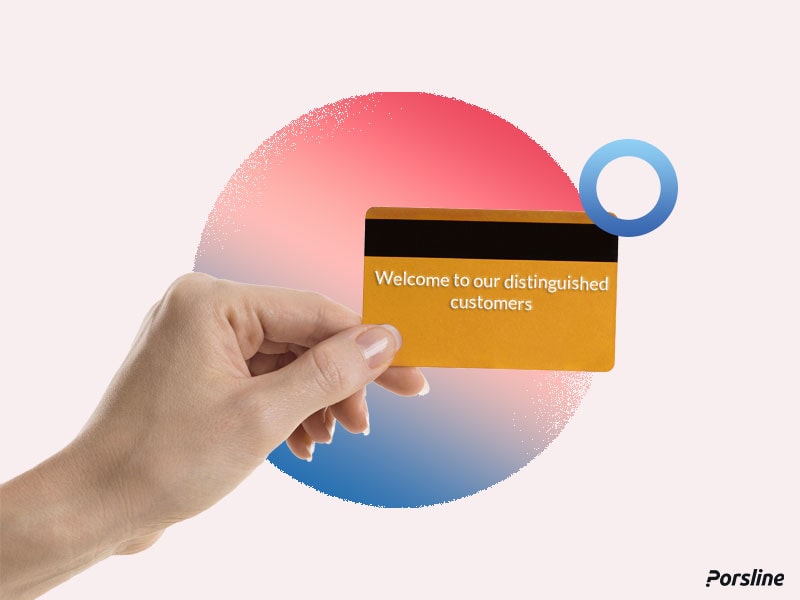The ultimate guide to drawing the customer journey map + some tools & examples
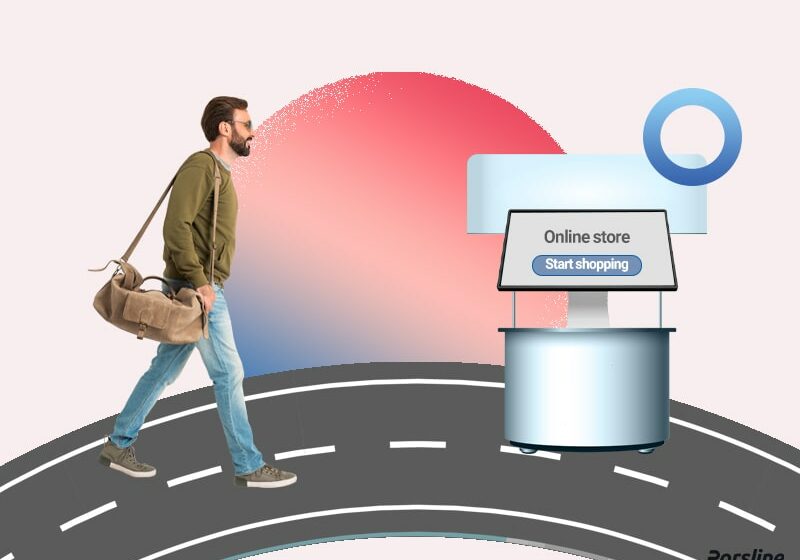
For many years, customer centricity has been the slogan of many companies, but have they actually been able to achieve this? Answering this question is not simple. That is why, in this post, we aim to talk more about customer journey map. Good knowledge of the business can provide business owners with good insight.
It is useful to know that, according to statistics, companies and organizations that worked on the customer journey map have been more successful than other companies that did not pay attention to the customer journey map. But the most interesting statistic showed that companies that have developed a customer-centered journey map have been six times more successful than those who have developed a company-centric customer journey map.
So what are you waiting for? Join us so that we give you an accurate explanation of the customer journey, customer journey map and its tools, in addition to some examples of practical customer journey map design.
What is a customer journey map?
Although customer journey is a term that may seem simple in its literary meaning, it is a concept that is practically not easy to reach. Every customer who interacts with your brand has his/her own story that, if carefully explored, can help to draw the customer journey map.
Suppose that a customer uses your service or buys products from you, then there are many points through which this person interacts and communicates with you, starting from the moment this customer gets to know you and your services to the moment he/she intends to buy your products or services. This includes the pre-purchase, consumption, and post-purchase stages.
A customer journey map is not complicated, it’s a visual story map that shows any customer interaction with your services or products. And when you want to get the customer journey map, you actually enter the mind of your audience, and by using the customer journey map, you can think instead of the customer and see where your business is doing well and where it is not.
The customer journey map shows what interactions your customer does on his/her journey with you and which needs are met. The more touchpoints customers have with your business, the more complex the design and formulation of a customer journey map can become
Why should you draw the customer journey map?
The customer-centric view is a point of view that is seldom considered by businesses. Most businesses seek to have standards that are important to their business, but what about customers and their needs? Usually, companies that care about customers’ needs and seek to meet them are the most prosperous.
Most businesses that care about customers and their needs (customer-centric) usually make six times the annual profit of businesses that focus more on the business (business-centric). Results of research and studies in this field show that customer-centric strategies can be more profitable than business-centric ones.
Achieving customer satisfaction acts as a powerful motive for business companies in customer experience management.
The more a customer is able to meet his/her needs by using a product or service for the company, the more loyal they are to this company.
How to draw a customer journey map?
A customer journey map is more about the customer than being about the business and its products and/or services. That is why we must have proper and sufficient knowledge of the customer to be able to draw the customer journey map.
But how can you gain the right knowledge of your customers? We have to admit that it is not easy to understand the reality of the customer, as their needs and desires are usually hidden in their minds. Nevertheless, there are solutions that companies can employ to gain a proper understanding of their customers.
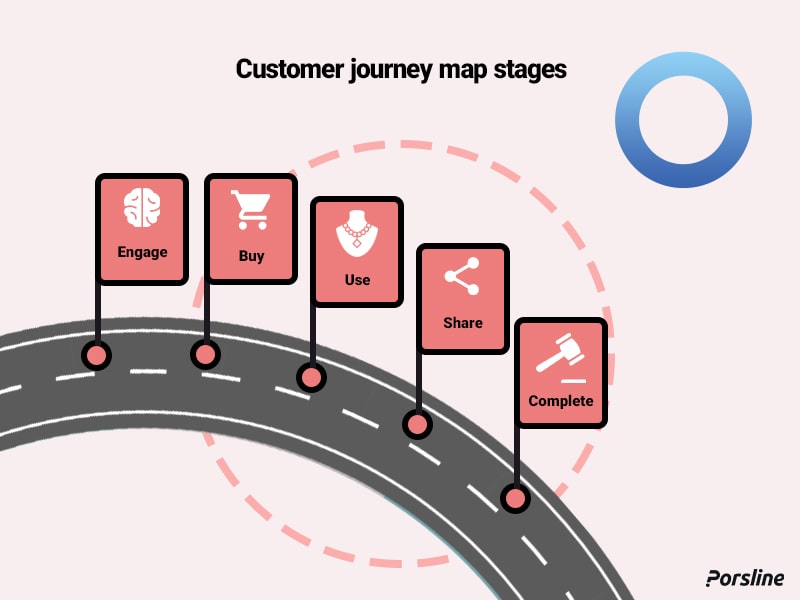
A customer journey map typically consists of five main stages, each of which has its own details, and these stages are:
- ENGAGE: At this stage, users can get to know your business, product, or service in a variety of ways. Sometimes they may see your advertisements on social media, find your site using search engines like Google, or through friends and acquaintances. Just at that moment, the journey has begun, and no matter how the user gets to know your products and business, you should keep in mind that the starting point is important.
- BUY: The second stage is buying, which means that, after being engaged in your business, the user feels that the products or services you provide meet one of his/her needs, and thus he/she pays for your product or service. Although many companies consider that buying is the last stage of customer interaction with the business, we must keep in mind that this is just the beginning of the journey and there is still a long way to go until the end of the customer journey.
- USE: At this stage, the user actually uses your product or service. In fact, all the possibilities that have formed in the mind of the user about your product or service are measured and evaluated upon actual use. Now if the user’s needs were met, he/she would become interested in your brand and business, otherwise, a negative view towards your business and brand might be formed in the user’s mind.
- SHARE: If users had a good experience during their journey at the previous stage in terms of actual use of your product and service, they would probably share this good experience with their friends and acquaintances. This stage can be valuable for your business because only then the level of users’ satisfaction with you is so high that they not only use your products and services themselves but also recommend them to others.
- COMPLETE: The final stage of the journey is where the role of the company comes in. If you can track users throughout their journey and reward them after they purchase, use, and recommend your product, you will have probably helped a lot in gaining customer loyalty. This could be achieved by paying attention to customers and their activities, and there is no need to do specific work. If customers feel that you pay good attention and appreciate what they have done, their satisfaction with your business may double.
Now that we are familiar with the customer journey, it is not a bad idea to examine these stages with a simple example. Suppose that you are a computer equipment manufacturer and you have done a lot of offline and online advertising for a new mouse. Maybe because the product is new, few people are familiar with it, so it is probably important that users should see your advertisements and visit your site. To draw a customer journey map, you should pay attention to all user touchpoints. For the first stage (ENGAGE) in our example, there are many touchpoints that will be mentioned below.
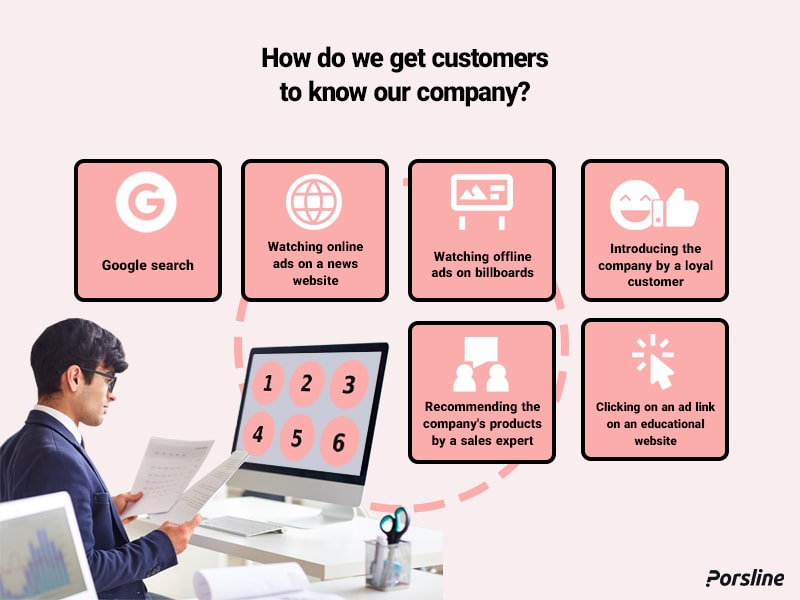
In the given example, the user may be interested in buying at any touchpoint that makes him/her get to know your business. Here, you should pay attention to the means by which a user makes a purchase.
As you see, the customer can buy from you in various ways. It is important to monitor your customers’ buying path because you can draw the rest of the customer journey by using the data available at the points of sale, whether they are online or offline.
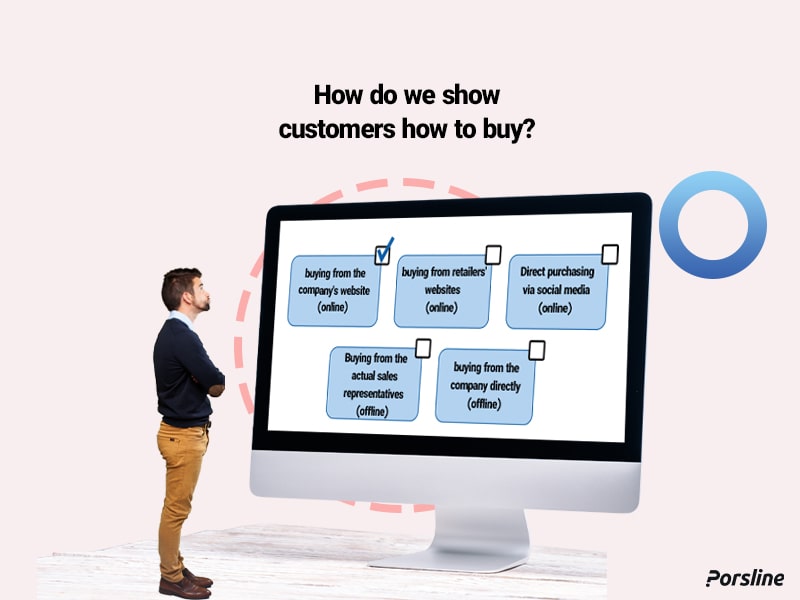
In the next stage, the customer uses the product, and then, you must use the data you have obtained from customers to ask them to express their experience of using the product. The question that arises here is how to receive customer feedback. In the following, we refer to some methods of getting customer feedback.
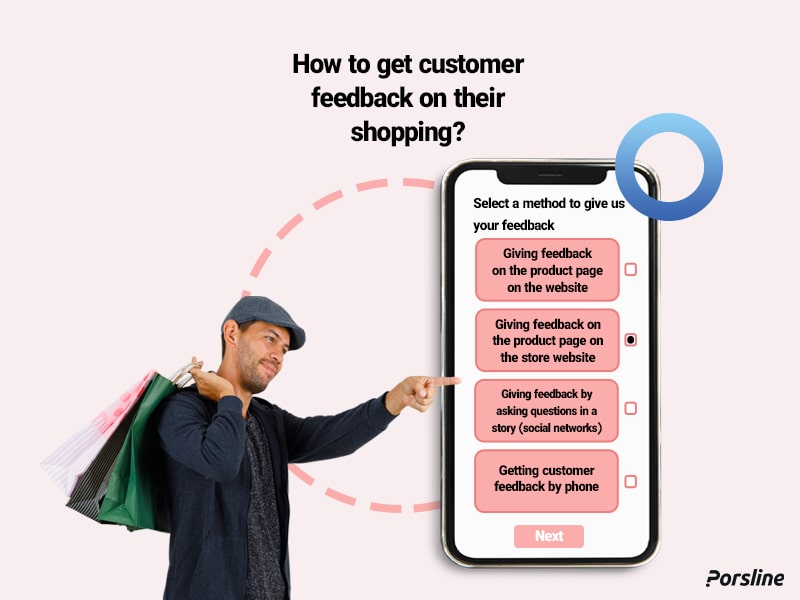
After that, your company must be able to hear the voice of customers. This is one of the most tricky stages of designing a customer journey map. Because, at this stage, we need to look at how customers talk about your business and product. Below are some possible cases.
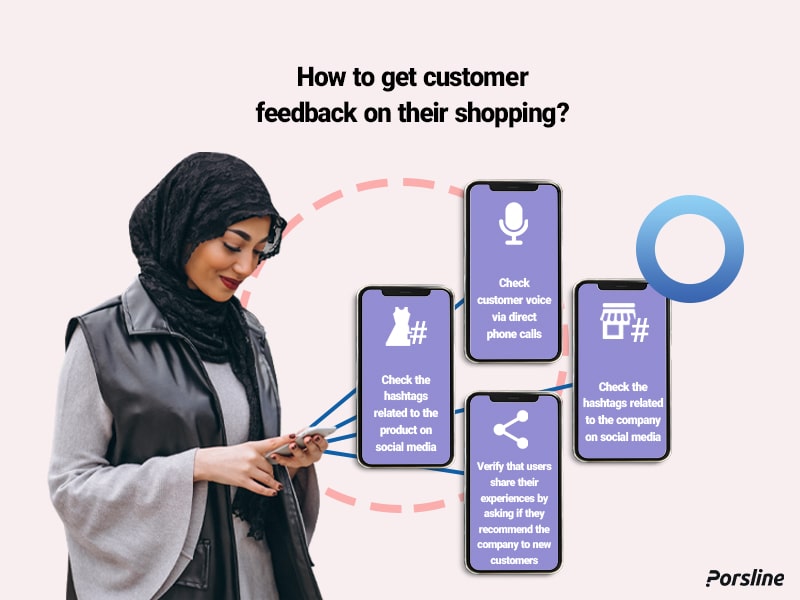
If you could monitor customers up to this stage, your business would probably be very successful. As this is where you need to ask customers about improvements. In fact, you can study other needs of customers or see what areas to improve to make customers more loyal to your business.
There are many ways to achieve and increase customer loyalty that you can use at the end of your customer journey. Here are some simple and practical examples that increase the probability of achieving customer loyalty.
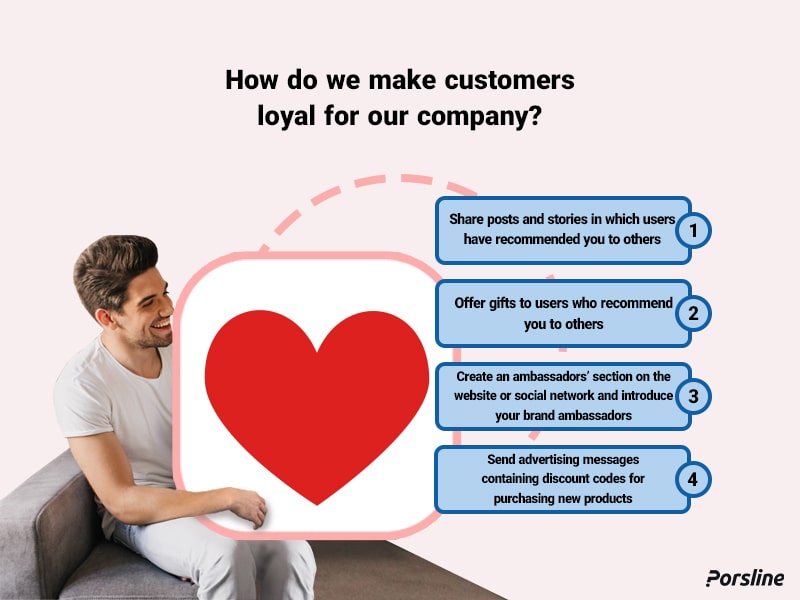
Although the given example is quite simple, it gives a relatively good view of different businesses. Of course, there are various layers to be considered in this context, which are:
- Actions: What does the customer do at each stage? What actions should be taken to reach the next level? (Here, do NOT mention what your company or partners like retailers do. We need to think about that when we examine the touchpoints.)
- Motivations: Why is the customer motivated to move to the next stage? What is it that he/she feels? Why does he/she care about your business?
- QUESTIONS: What are the uncertainties, terms, or other things that prevent the customer from moving to the next stage? You should pay attention to the user questions, as a place where there are many user questions may be a good space for companies and organizations to way in.
- BARRIERS: What are the structural, financial, operational, or other barriers that prevent customers from moving to the next stage?
The tools needed to draw the customer journey map
In the past, probably finding the exact needs of customers (real needs) was not an easy task. But today, thanks to online and digital tools, it has become much more easier. In order for companies to draw a customer journey map, they need to deeply identify customers’ needs.
As mentioned earlier, there are various solutions to accurately identify the needs of customers. Hereby, we refer to some of the appropriate tools to do this correctly.
- Questionnaire: A questionnaire is one of the oldest and most practical research tools for identifying customer needs. And today with the availability of online form-builder tools, companies can easily create questionnaires to identify their customers. In this context, Porsline can be useful as one of the appropriate tools for designing and creating online forms, surveys, and questionnaires. In the following and the final section, we will mention a detailed explanation of the tools and services that Porsline can provide you in order to draw your customer journey map.
- Story questions: Another method that can help us these days to get more accurate information about customers’ needs is asking various questions through the stories on social networks (specifically Instagram). This includes a variety of questions (two-choice, four-choice, short answer) that can be used to know the customer’s opinion, taste, and interests. All these are done for market research to know what customers need, what their motivations and questions are, and to better evaluate the barriers they may encounter.
- Data related to analysis tools: Nowadays, websites are usually analyzed using an analysis tool, one of the useful site analysis tools is Google Analytics, which can be used to know where each user entered the site, the path they took on the site, and what was the shape of our customer’s journey on the site. By analyzing and reviewing these journey routes on the site, you can get the appropriate data for designing and formulating the customer journey map.
- Focus group meeting: Focus group meetings are meetings in which various topics about the brand and the product or service can be discussed face-to-face with the customer. The advantage of this technique is that customers are directly connected to you without any intermediary. So, they talk about their needs, problems, and issues related to your brand or product and service, enabling you to deeply identify their needs. Of course, focus groups are used to be held in person, but today they can be held online thanks to tools such as Google Meet, Skype, WhatsApp, Telegram, and similar software.
How does Porsline help you draw the customer journey map?
You need two foundations to build a practical customer journey map:
- The first one: the audience
- The second one: the right tool
If you don’t know your customers and don’t use the right tools to get to know them, you won’t be able to properly draw their journey map.
Say you have a website for a stationery store. If you don’t know whether your audience is the parents or children, then how can you make the right decision?
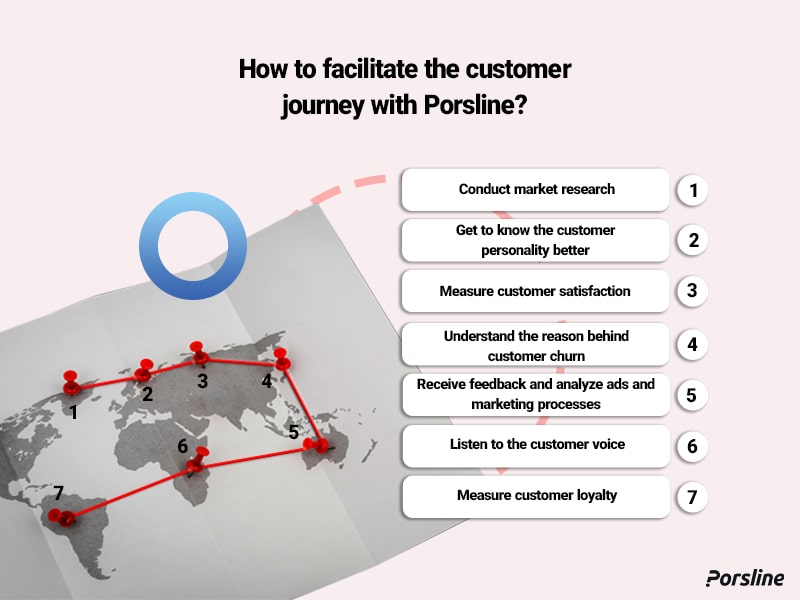
In order to get to know your audience correctly, you can use Porsline online form, survey, and questionnaire builder to create different types of market research and audience recognition surveys.
Also, use market segmentation surveys to determine the different segments of your customers, as these market surveys show you exactly who your audience is, what your customer needs are, and how you can meet those needs and desires. Thanks to these surveys, you can determine the best way to approach your customers and market your products and services to them.
- On which social networks should you be more active?
- Should you use billboards or online advertising for marketing and informing your audience about your products?
- Which is more important to you, having an online store or creating a specific app for your brand?
- Do you need to expand your branches to different places or is it enough to have a head office?
Of course, you can also use Porsline at other touchpoints of the customer journey.
After the task of getting to know your customers has become clear, it is time to find out why customers might not come back to buy from you again, why your advertisements do not lead to good results, and why there are so many dissatisfied customers.
To answer these questions, you can also use the customer satisfaction survey, the customer churn survey, or the advertising test survey and collect the necessary feedback. When you have the right data, you can make better decisions, and these surveys provide you with the right and unbiased data so you can make the necessary changes in your next processes.
In the next stages of the customer journey, you can use other Porsline online forms to receive the voice of customers and increase their loyalty.
If creating customer feedback pages on your website is not an easy task or you even don’t have a website to do it at all, you can easily create an online form on Porsline, send it to your customers via SMS or embed it on your website and receive the feedback from customers. Afterward, you can use advanced features such as email notifications so that you are automatically notified after receiving customers’ comments and then make the necessary changes.
Use the NPS survey or Net Promoter Score Index and the customer loyalty survey to know what percentage of your customers are loyal to you and why they have not bought from you again. This way, you can solve potential problems or reinforce your strengths.
For more information about Porsline features, you can watch Porsline video tutorials and get to know more about its capabilities.
Examples of customer journey maps
In order to be able to understand and better design your customer journey map, we will review in this section some interesting examples of the customer journey map of famous companies.
Lego brand
It is good to start with one of the most famous companies in the world. LEGO is very famous for its creativity and innovation. The image below shows the Lego customer journey map.
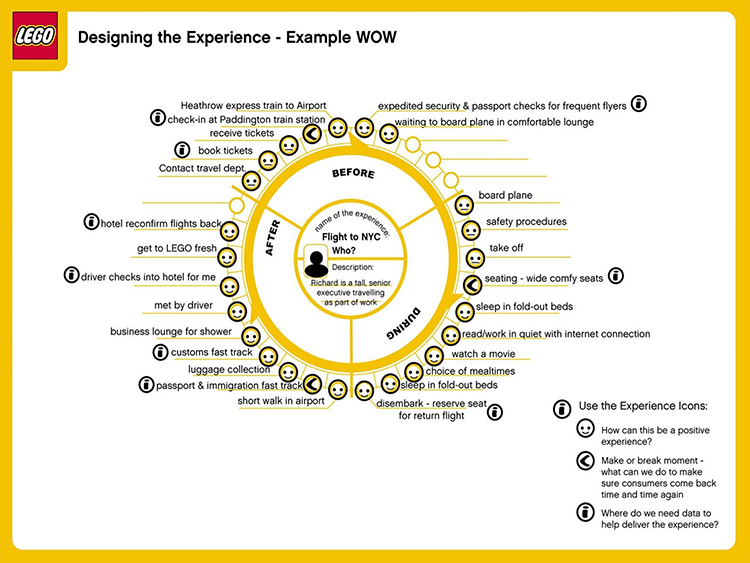
The Lego customer journey map was designed to be simple and familiar. If you look at the center of this map, you will see that Lego has considered a specific persona of its audience.
In the next layer, three sections can be seen: BEFORE the audience gets to know the products, DURING the use of the products, and AFTER using the products. These three sections determine how the customer journey goes from the beginning to the end.
In the next layer, the details of the touchpoints and communication of Lego customers with this group are mentioned. And as you can see, there are symbols in front of each section. The emoji icons show the situations in which you can create a good customer experience. The letter (i) refers to areas where you should collect data to achieve a better customer experience, and the (<) mark indicates times when we can do something to make sure customers come back to your business.
For example, say you order a taxi online to go to work, then the best time for an online taxi business to recognize you and send you an amazing offer is 8 am when you go to your workplace.
So as you can see, this structure can be a simple and practical method. Even when you are in an interview with your customers, you can draw this map on a simple piece of paper and specify the symbols you want. It is a good idea to draw this map for your business and see how you can keep up with your customers so that they are more satisfied with your business, products, and services.
IKEA brand
Another example is the IKEA customer journey map. This map shows the path that the customer takes when he/she enters an IKEA store and what touchpoints should be considered.
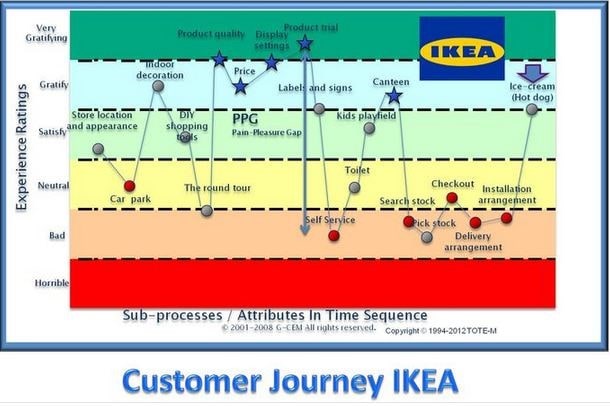
As you can see in the image, the IKEA customer journey map extends across six layers. The lower layers show critical points which may not form good experiences, and as we go up, we have points that may probably achieve a high level of customer satisfaction. This method of drawing a customer journey map is also very practical, and actually in this method, you specify on one simple piece of paper the path of the customer interaction with you, and in which position and conditions each of the touchpoints are placed.
It would be better to study some of these touchpoints together. If you look closely at the image, the car park probably attracts your attention in the second interaction of the customer with the business. It is true that in our opinion, the customer’s car parking may not have much to do with his/her satisfaction with our products and services, but you should be aware that these points can be of great importance.
Moreover, if we go a little further, we come to a point that indicates that Ikea has made a space for children to play “the kids’ playfield”. As you can see, this point is located in the green area and has achieved a very sweet and pleasant experience for the customer.
Now, you can draw another customer journey map for your business with this method. Put the two maps together and study their similarities and differences, as these two different views can reveal facts, to which you may have paid less attention. Just do NOT forget that in order to draw the customer journey map, you should look at the business from the customer’s point of view and not from your own!
Conclusion
Finally, it should be noted that the customer journey map is not a complicated matter because it is enough to look at the business, products, and services from the eyes of customers. Identify customer needs and understand where exactly in the path you have a problem that needs fixing. A customer journey map is not a single recipe that works for all businesses, and to draw it, you need to precisely identify the business, target audience, processes, products, and services of that particular business. As a result, it is necessary for employees from inside the company to work with the customer journey map design team in order to create an appropriate customer journey map.




